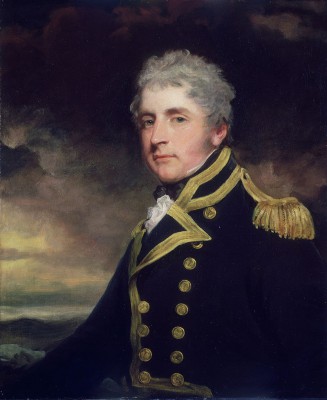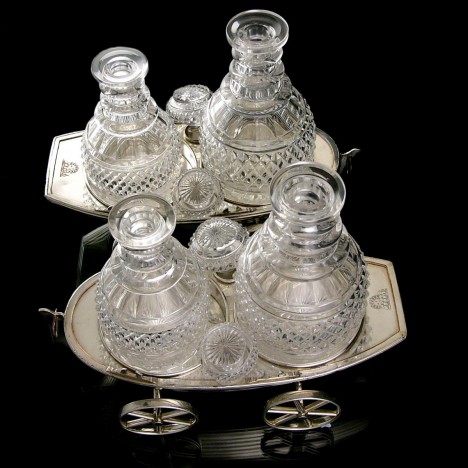Pushing the boat out: Captain Henry Blackwood’s silver jolly boats

A very rare pair of George III Old Sheffield Plate “Jolly Boat” wine trolleys, circa 1810, engraved with the family crest of Blackwood for Admiral Sir Henry Blackwood (1770-1832). Length of each 33cm (13in)
This very rare pair of Old Sheffield Plate double wine coasters recalls one of Admiral Lord Nelson’s most admired frigate captains, and a hero of the battle of Trafalgar, Captain Henry Blackwood. The coasters are designed as clinker-built rowing boats each set on a pair of detachable axles with spoked wheels, the interiors with two circular depressions for decanters and two for stoppers, rope-ring attachments to bows and engraved on the stern thwart with the armorial crest of ‘the sun rising from behind a cloud, all ppr.’ as granted to Captain Blackwood (1770-1832) at the creation of his baronetcy (Blackwood of the Navy) in the baronetage of the United Kingdom on 23 July 1814.
The coasters, which are complete with a matched set of two large and two smaller Regency decanters, give a fascinating glimpse into the shipboard dining custom of Napoleonic war naval officers. At sea, Jolly Boat wine trolleys were dismounted from their wheeled carriages. It was customary at the table after pouring out wine or spirit from the decanter, to return it to the stand and push it along to the next officer. It is believed that the saying ‘to push the boat out’ has its origins in this old naval custom as the officer paying for the wine was the first to start the jolly boat off round the table.
Prior to the first meeting between Nelson and Blackwood, the national hero was already a dedicated supporter and admirer of his subordinate’s vigilance, seamanship and willingness to close with the enemy. On the night of 30 March 1800 it was Blackwood in the small frigate Penelope that maintained the close pursuit of the 80-gun Guillaume Tell, the strongest French ship to survive the Battle of Nile, alternately pouring crippling broadsides into the vastly superior vessel’s stern quarters until larger British ships could catch up – a feat that later caused Nelson in communication with Blackwood to write ‘Is there a sympathy which ties men together in the bonds of friendship without having a personal knowledge of each other? If so (and I believe it was so to you), I was your friend and acquaintance before I saw you. Your conduct and character on the late glorious occasion stamps your fame beyond the reach of envy. It was like yourself; it was like the Penelope. Thanks; and say everything kind for me to your brave officers and men …’
Blackwood was born in County Down, Ireland, the seventh son of Sir John Blackwood, 2nd Baronet of Killyleagh, and his wife Dorcas (Stevenson), 1st Baroness Dufferin and Clandeboye. He entered the navy as a volunteer 1781, serving in the Mediterranean, and on the Newfoundland station, steadily gaining the confidence of his superiors, and developing a flare for frigate operations. He was made lieutenant in 1790 by Lord Howe serving in Invincible at the battle of the First of June (1794). He twice turned down the command of a 74-gun ship-of-the-line for the special opportunities offered in frigate service taking command of the 36-gun frigate Euryalus when war broke out again in 1803 after the Peace of Amiens. In 1805 he brought the news to London of the breakout of the French and Spanish fleets from Ferrol and their entrance into Cadiz, halting briefly at Merton in the early hours of the morning to inform Nelson, who went with him to the Admiralty, and received his final instructions to resume the command of the fleet without delay.
When Nelson sailed in Victory for Cadiz a few days later, Blackwood and Euryalus went with him.On the morning of Trafalgar, 21 October 1805, Blackwood was invited on board Victory and received a freehand in commanding all the frigates in assisting any disabled ships. He was further given permission to make use of Nelson’s name in ordering any of the stern most line-of-battle ships to do what struck him as best. Blackwood together with Captain Hardy also witnessed the subsequently disregarded codicil to Nelson’s will – ‘I leave Emma, Lady Hamilton therefore a legacy to my King and Country that they will give her an ample provision to maintain her Rank in Life.’ Anxious for his commander’s safety, Blackwood unsuccessfully tried to persuade Nelson to shift his flag to Euryalus. It was not until afternoon with shot flying thickly over the flagship, that Blackwood was finally ordered by Nelson back to his frigate with the words ‘God bless you, Blackwood, I shall never speak to you again.’ Immediately after the battle Collingwood hoisted his flag in Blackwood’s ship, but after ten days removed it to Queen, and Euryalus was sent home with despatches and with the captured French admiral Villeneuve. Blackwood landed at Falmouth and was one of the first messengers to use the Trafalgar Way to deliver his dispatches to the Admiralty in London. He also handed Nelson’s personal effects, bloodstained uniform and codicil in person to the hysterically grieving Emma, Lady Hamilton becoming for a time mixed-up in the mounting controversy surrounding the admiral’s final intentions towards his mistress. At Nelson’s funeral (8 January 1806), Blackwood acted as train-bearer of the chief mourner, Sir Peter Parker, the aged admiral of the fleet.Appointed to Ajax (80 guns), in 1807 Blackwood joined the squadron under Sir John Duckworth in the expedition up the Dardanelles. At the entrance of the straits, on the night of 14 February 1806, the Ajax caught fire through the drunken carelessness of the purser’s steward, and was totally destroyed, with the loss of nearly half the ship’s company. Blackwood himself was picked up hanging on to an oar, almost perished with cold, after nearly an hour in the water. Declining a post at the Navy Board, Blackwood was then appointed to the command of Warspite (74 guns) in which he joined the very harassing blockade of Toulon. He returned to England at the end of 1812, but remained in command of the Warspite for another year. On 4 June 1814 he attained the rank of rear-admiral, and in August 1819 was nominated a KCB, and appointed commander-in-chief in the East Indies, from which station he returned in December 1822. He became vice-admiral in May 1825, and from 1827 to 1830 he was commander-in-chief at the Nore.
Blackwood married three times. On 12 January 1795 he married Jane Mary, née Crosbie; she died on 19 January 1798, without surviving children. On 3 June 1799 he married Eliza, daughter of Martin Waghorn; they had one son (later the second baronet) and she died on 30 October 1802. On 9 May 1803 he married Harriet, née Gore; they had several children and she died on 5 May 1851. Two of his sons became captains in the navy. Blackwood died on 17 December 1832, at Ballyleidy, the seat of his eldest brother, Lord Dufferin and Claneboye. Blackwood was typical of that generation of daring frigate captains, including Edward Pellew and William Hoste, which was immortalized to brilliant effect in Patrick O’Brian’s fictional Jack Aubrey. However, undoubtedly his greatest fame today lies in his intimate role in the last day of Nelson’s life and his actions in the immediate aftermath of Trafalgar.


